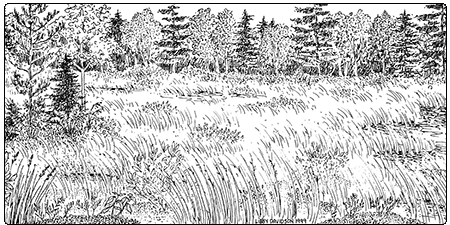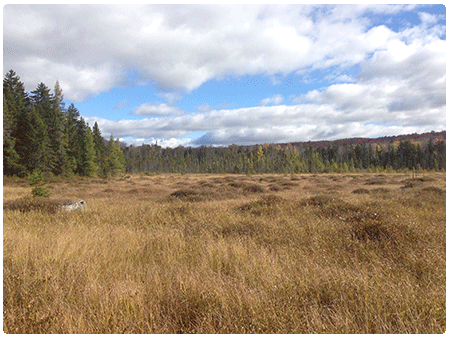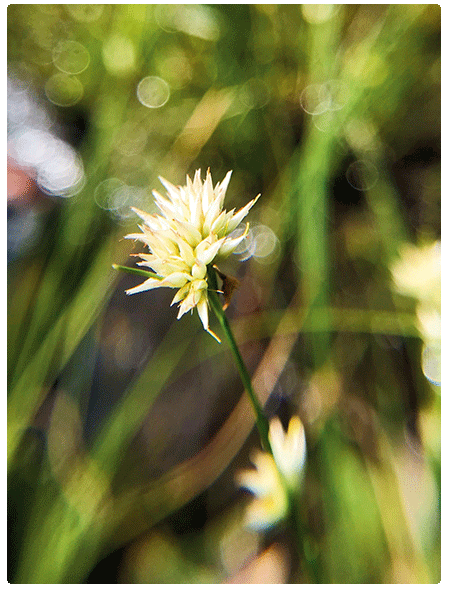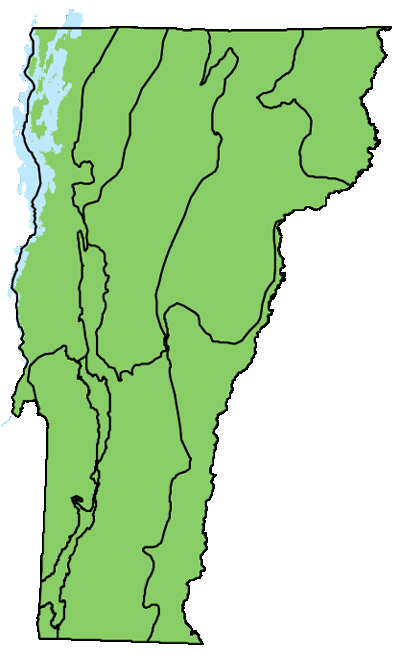Ecology and Physical Setting 
Intermediate Fens are recognizable from a distance by their tall and swaying fine-leaved sedges. They may look like inviting grassy lawns, but a step into one of these fens quickly reveals the quaking and unstable peat surface. In addition to the tall sedges, these open peatlands are dominated by brown mosses, and they have a variable cover of low shrubs. These fens are fed by ground or surface water that is moderately enriched with dissolved minerals and has a pH ranging from 4.8 to 7.4. On average, this community type is slightly more acidic than Rich Fen, so it is considered intermediate between Rich Fen and Poor Fen. Intermediate Fens are wet and commonly have water at or slightly above the surface of the peat for most of the growing season.
 Intermediate Fens are commonly found in former lake or pond basins that have been partially filled by peat deposits. In many cases, a central pond remains and there is a floating peat mat held together by sedge and shrub roots that extend over the alkaline lake or pond water. Fens with floating mats of this type may also be found extending over the very slowly moving water of rivers and streams flowing through peatland complexes. Near their shoreline edges, these pioneering mats may be weakly supported by a suspension of flocculent peat and colloidal lake sediments, all of which give a false impression of structural integrity to the curious but unwary naturalist who may take an ill-fated step onto the mat.
Intermediate Fens are commonly found in former lake or pond basins that have been partially filled by peat deposits. In many cases, a central pond remains and there is a floating peat mat held together by sedge and shrub roots that extend over the alkaline lake or pond water. Fens with floating mats of this type may also be found extending over the very slowly moving water of rivers and streams flowing through peatland complexes. Near their shoreline edges, these pioneering mats may be weakly supported by a suspension of flocculent peat and colloidal lake sediments, all of which give a false impression of structural integrity to the curious but unwary naturalist who may take an ill-fated step onto the mat.
Intermediate Fens typically have deep peat deposits that range from three feet to over 13 feet. The poorly decomposed peat is generally sedgy, with some moss and wood fragments present. In deeper basins, it is common to find lake sediments underlying the peat, including gyttja, a greenish, gelatinous, organic sediment made up of consolidated colloidal lake sediments comprising the remains of planktonic diatoms and algae. The gelatinous gyttja, the loose colloidal sediments, and the overtopping fibrous peat mat all tell a story of lake infilling that has occurred over millenia.
Vegetation

Although there may be occasional tall boggy hummocks in Intermediate Fens, the majority of these fens are open and relatively flat. Some have low hummocks and wet hollows. Woolly-fruited sedge is the dominant herbaceous plant, and this tall, gracefully bending sedge may be all that is visible when looking across an expanse of fen. However, there are usually many other shorter herbaceous plants present as well. Characteristic among these are water sedge, twig rush, and bog-bean. Shrubby cinquefoil may be abundant in some fens, as may sweet gale. Other vascular plants that vary in their abundance are Hudson Bay bulrush, white beakrush, bog goldenrod, single-spike muhlenbergia, mud sedge, marsh cinquefoil, alder-leaved buckthorn, small cranberry, hoary willow, and bog rosemary.
Bryophytes form nearly 100 percent cover under the sedge layer in some areas. In pond shore situations, bryophytes may be very sparse. Starry campylium is typically the dominant moss and is a good indicator species for Intermediate and Rich Fens. Other mosses include Calliergonella cuspidata, Tomenthypnum nitens, and Sphagnum warnstorfii. The rare mosses Paludella squarrosa and Scorpidium scorpioides are also characteristic. Where Intermediate Fens are pioneering mats over alkaline ponds or slowly moving streams, Sphagnum teres, Sphagnum subsecundum, and Straminergon stramineum may all be common. The thallose liverwort Moerckia hibernica is a calcium-loving plant that is commonly found in mineral-rich fens.
Wildlife Habitat
Some breeding birds of Intermediate Fens include common yellowthroat, swamp sparrow, and Wilson’s snipe. Ring-necked ducks and American black ducks may breed at sites that have ponds and stable peat surfaces, with hummocks large enough to support their nests above water levels. Several species of dragonflies are associated with Intermediate Fens, including belted whiteface, elfin skimmer, and ebony boghaunter. The sedge sprite is a small damselfly found in fens and other wetlands with dense sedges and grasses. Green frogs are found in Intermediate Fens at pond margins. Four-toed salamanders breed in fens with moist, mossy hummocks and hollows.
Related Communities
- Rich Fens typically occur on gentle slopes, usually with shallower peat. They are grounded to mineral soil or bedrock and do not form floating mats. They are strongly influenced by mineral-rich groundwater associated with calcium-rich bedrock or till, and are dominated by low sedges and non-sphagnum mosses.
- Poor Fens receive ground or surface water that is less mineral-rich than that of Intermediate Fens. Poor fens are dominated by sphagnum mosses, sedges, and heath shrubs, and have well-developed hummocks and hollows.
- Sweet Gale Shoreline Swamps share many species with Intermediate Fens and occur in similar settings. They are distinguished by the dominance of sweet gale and other shrubs.
Conservation Status and Management Considerations
Intermediate Fen is a rare community type in Vermont, with all known examples smaller than 40 acres. Most examples are only several acres in size. Fens that develop and are maintained under the influence of mineral-rich ground or surface water are threatened by alterations in the quality or quantity of the associated groundwater. Examples of Intermediate Fens that occur along shorelines of ponds or slowly moving streams are threatened by alteration of water levels or natural hydrologic regimes. The vegetation in fens is extremely susceptible to trampling, so visits should be limited to sites with boardwalks or to the uplands adjacent to fens. Although there are some high-quality examples of this community type on conserved lands, additional sites should be protected. Vermont has some of the best examples of this community type in the Northeast.
Distribution/Abundance
Intermediate Fens are found throughout Vermont, both in isolated basins and along slow-moving streams and pond shores. Similar communities are found throughout New England, the Lake States, and north into Canada.
Characteristic Plants
Trees (Stunted)
Occasional Species
Northern white cedar – Thuja occidentalis
Tamarack – Larix laricina
Shrubs
Abundant Species
Sweet gale – Myrica gale
Occasional to Locally Abundant Species
Shrubby cinquefoil – Dasiphora fruticosa
Alder-leaved buckthorn – Rhamnus alnifolia
Small cranberry – Vaccinium oxycoccos
Bog rosemary – Andromeda polifolia
Leatherleaf – Chamaedaphne calyculata
Herbs
Abundant Species
Woolly-fruited sedge – Carex lasiocarpa
Occasional to Locally Abundant Species
Bog-bean – Menyanthes trifoliata
Hudson Bay bulrush – Trichophorum alpinum
White beakrush – Rhyncospora alba
Bog goldenrod – Solidago uliginosa
Single-spike muhlenbergia – Muhlenbergia glomerata
Mud sedge – Carex limosa
Marsh cinquefoil – Comarum palustre
Intermediate bladderwort – Utricularia intermedia
Bryophytes
Abundant Species
Starry campylium – Campylium stellatum
Occasional to Locally Abundant Species
Moss – Calliergonella cuspidata
Moss – Hamatocaulis vernicosus
Moss – Scorpidium revolvens
Moss – Tomenthypnum nitens
Moss – Sphagnum warnstorfii
Moss – Sphagnum teres
Moss – Sphagnum subsecundum
Moss – Straminergon stramineum
Rare and Uncommon Plants
Dragon’s mouth – Arethusa bulbosa
Showy lady’s slipper – Cypripedium reginae
Bog wintergreen – Pyrola asarifolia
Livid sedge – Carex livida
Creeping sedge – Carex chordorrhiza
Water sedge – Carex aquatilis var. substricta
Greenish sedge – Carex viridula
Few-flowered spikerush – Eleocharis quinqueflora
Twig rush – Cladium mariscoides
Common arrow-grass – Triglochin maritima
Slender cottongrass – Eriophorum gracile
Bog wintergreen – Pyrola asarifolia
Bog willow – Salix pedicellaris
Moss – Sphagnum pulchrum
Moss – Pseudocalliergon trifarium
Moss – Tomenthypnum nitens
Moss – Paludella squarrosa
Hooked scorpion moss – Scorpidium scorpioides
Associated Animals
Green frog – Lithobates clamitans
Red-bellied snake – Storeria occipitomaculata
Common yellowthroat – Geothlypis trichas
Swamp sparrow – Melospiza georgiana
Wilson’s snipe – Gallinago delicata
Sedge sprite – Nehalennia irene
Belted whiteface – Leucorrhinia proxima
Rare and Uncommon Animals
Four-toed salamander – Hemidactylium scutatum
Spotted turtle – Clemmys guttata
Ring-necked duck – Aythya collaris
American black duck – Anas rubripes
Bog copper – Lycaena epixanthe
Ebony boghaunter – Williamsonia fletcheri
Elfin skimmer – Nannothemis bella
Places to Visit
Chickering Bog Natural Area, Calais, The Nature Conservancy
Hall’s Creek, Eagle Point Wildlife Management Area at Missisquoi National Wildlife Refuge, Derby, Vermont Fish and Wildlife Department (VFWD) and U.S. Fish and Wildlife Service
Pond Woods Wildlife Management Area, Benson and Orwell, VFWD
